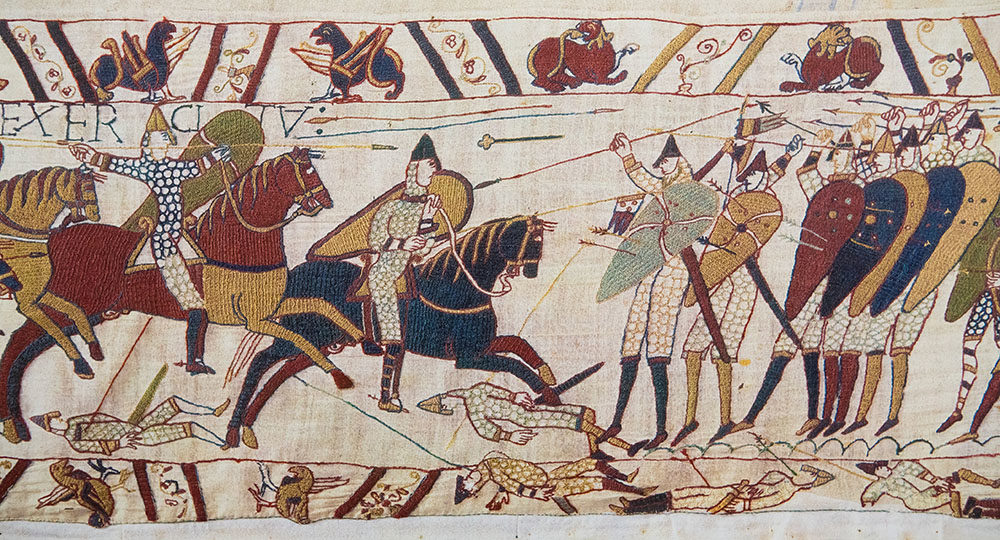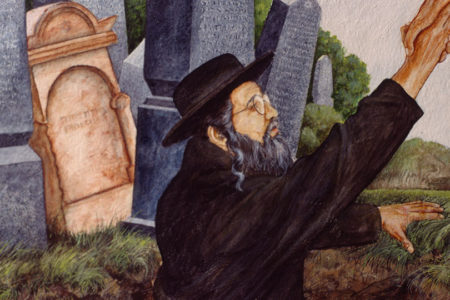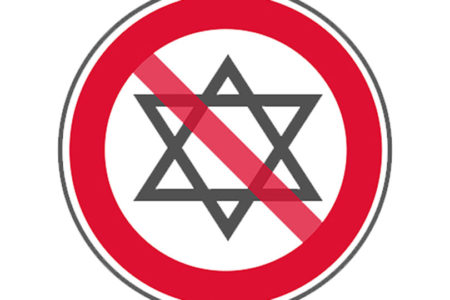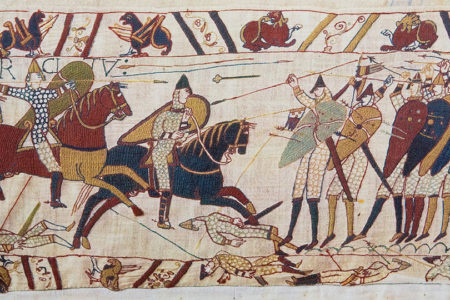Anti-Semitism in the Middle Ages
Leon Poliakov has written, “During the second half of the fourteenth century, anti-Jewish hatred reached such a peak that we can confidently date from this period the crystallization of anti-Semitism in its classic form, the form that later led Erasmus to observe: “If it is the part of a good Christian to detest the Jews, then we are all good Christians.’”1 Is it any wonder that Jews often respond to the claims of Christ by saying, “We do not need any dialogue with Christians. The best they have to offer has been demonstrated by 2,000 years of church persecution.”
Most Christians are shocked and baffled to hear of such atrocities. But this is understandable, for they have little insight into the centuries of Jewish persecution, often initiated and encouraged by the church, especially during the Middle Ages, a period of a thousand years often referred to the “Dark Ages”—and so it was for the Jews of Europe.
590–1000
At the beginning of this period, church councils had already mandated strict regulations against Jewish/Christian relationships. Gregory of Tours (590–604) forbid Christians to eat with Jews, participate in mixed marriages, observe any of the Sabbath prohibitions on Sunday, or mingle with them during the Easter festival.2 He also restricted Jews from holding any office or authority over Christians.
During this period, persecution against the Jews was based on the belief that they were the enemies of God. Church fathers saw it as their God-given duty to preach against the Jews. They were characterized as “liars to God,” “closeminded,” an “ever-incredulous race,” a “wicked and perfidious nation.”3
In Spain in 613, Jews who refused baptism were expelled from the country, and all their children over seven years of age were taken to be reared as Christians.
Although the prevailing attitude during the sixth century was to restrict and humiliate the Jewish population, such was not the case for all areas of Europe. Jews living in Carolingian Europe enjoyed a favorable status, which led to rapid multiplication of their settlements. In these areas the bishops, kings, and nobles granted Jews a broad autonomy, allowing them to administer their own communities and live according to their own laws.4
1000–1294
Unfortunately, such favorable status was short lived, for rumors reached Europe that an Arab, Emir Al-Hakim, had desecrated the Holy Sepulcher in Jerusalem, beheaded the city’s patriarch, and was persecuting Christians. The church took revenge, but it was directed at innocent Jews living in Europe during 1010 to 1012.5
Emir Al-Hakim’s persecution precipitated a number of Christian Crusades; the first taking place in 1096. Knights, monks, and commoners were galvanized into a European army that donned a red cross on its garments and went forth to recapture the Holy Sepulcher, avenge the death of Christians, and deliver Jerusalem: from Islamic rule. As the legionnaries marched through Germany and France, they took vengeance on innocent Jews, destroying their villages and massacring thousands.
The Second Crusade in 1146, instituted by Pope Eugenius III, was greatly promoted through the preaching of St. Bernard of Clairvaux and marked-a new age for anti-Semitism in Europe. During this period Jews were falsely accused of profaning the “Host” and committing “blood libels.” The Roman Catholic Church teaches that the Host is a consecrated wafer that turns into the actual body of Christ during the Mass. Accusations were spread throughout the church that Jews tried to renew agony to the body of Christ by stabbing, tormenting, and burning the Host. They also taught that Jews were committing blood libels by kidnapping innocent Christian children, ritually murdering them, and using their blood in the making of unleavened bread for Passover. Such allegations were pure myth.
When the Crusades swept Europe, many Jews converted their property into possessions such as gold and silver, which could be concealed easily in the event of an attack. Because legal tender was extraordinarily scarce at that time, its possessor naturally turned to the practice of usury (money lending). However, the church regarded the practice of usury as endangering the eternal salvation of its flock, and all who engaged in it were excommunicated from the church. But the church subsequently endorsed the practice of usury by the Jews, for they were already considered lost souls. Thomas Aquinas said that they were condemned to perpetual servitude because of their crime of usury.6
The profession of usury brought wealth to many Jews, but it also brought them much sorrow. The image of money-hungry Jews, desiring to control the world’s wealth and taking every opportunity to either cheat or squeeze the last dollar out of a deal, developed in Europe. This caricature was further expressed by Shakespeare’s Shylock in The Merchant of Venice and Dickens’ Fagin in Oliver Twist. In no way, however, were these characters a true portrayal of the Jewish moneylender.
Jewish moneylenders also became pawns in the hands of kings, churchmen, and noblemen. They were often arrested, tortured, or expelled according to a prince’s whim or the state of his treasury.7 In some cases, Jews were put in an untenable position: convert to Christianity or forfeit all their property. If they converted to Christianity, they were disinherited by Judaism. Refusal to convert meant that they not only had their property confiscated but were often burned at the stake.
In order to escape the collective trauma brought on by such severe persecution, Jews turned to the inner world of Talmudic studies and wrapped themselves in the solace of religious thought. This made them seem strange and different to the-Gentiles who lived around them. Study and debate of the Talmud also produced very sharp Jewish minds. They became wise bargainers and quick wits, which engendered greater hostility from the Gentiles with whom they had to deal.
During the Middle Ages, Jews were required to wear distinctive clothing to identify themselves to the Gentile community. Jews in Germany were made to wear pointed hats. In some sections of Germany, Jewish women were required to wear bells on their dresses so Gentiles could hear them approach. In 1253, England required the Jew to wear a badge. By 1275, Edward I stipulated that every Jew seven years of age and older must wear a yellow badge.8 The Jews of France were required to wear a red and white circular badge. Jews in Spain wore a “badge of shame,” consisting of a patch of yellow cloth with a red bull’s eye in the center. They were to dress only in pale green, a sign of mourning for the destruction of their Temple, because they had rejected Jesus. Failure to obey the edict brought a fine and the stripping off of the offender’s clothes wherever he was found.9 In Rome, Jewish men were made to wear a coarse red cape and women a red apron.
The story of the wandering Jew first emerged in the 13th century. The concept was based on an incident that took place at Jesus’ trial. The high priest had asked Jesus a question. He gave what was considered a disrespectful answer, whereupon the high priest’s officer slapped him (Jn. 18:20–22).10 Thus developed the church legend that, as punishment for this act, Jews were condemned to wander endlessly throughout the world until Christ’s Second Coming. This myth fanned the flames of anti-Semitism by picturing Jews as unstable vagabonds. By the 17th century, a gross exaggeration of the wandering Jew had developed. He was portrayed as a tall, hunch-backed man with long hair and a beard, wearing a threadbare garment. Later, this image was transferred to the well-known figure of the Jewish peddler.
1300–1517
At the beginning of the 14th century, Jews suffered greatly in what was called the “Shepherd’s Crusade” (1320). Hoards of people moved south, living off the land, pillaging as they went, and chose Jews by preference as victims. According to one source, at least 140 Jewish communities were exterminated by the “shepherds.”11
In the summer of 1321, a rumor surfaced that lepers and Jews had plotted to put all Christians to death by poisoning their wells and springs. This was the first concrete charge that Jews were plotting the destruction of Christendom.12 Needless to say, this diabolical myth resulted in the massacre of many Jews.
From 1347 to 1350, the “Black Plague” (bubonic plague) swept across Europe, killing at least one third of the population. It was called the Black Plague because its victims’ skin turned black with disease. This epidemic did not infect the Jewish population as severely because of their strict sanitary practices, but their immunity from the epidemic led to speculation that the Jewish population had spread the disease by poisoning wells. Mobs, known as “flagellants,” moved without restraint throughout Europe, destroying 350 Jewish communities. Emperors guaranteed immunity from prosecution to anyone who murdered a Jew.13
Following the plague, persecution of the Jews subsided somewhat, but they still suffered great abuse. By 1361, the financial plight of Europe had become so acute that “many devices were employed by rulers and petty princes to extort money from the Jews. Taxes had to be paid by them in order to travel, enter or leave a city, to get married, to bear children, and even to be buried … The privilege of fleecing the Jews was sold to princes and noblemen, who extorted large sums of money on trumped-up charges under the threat of expulsion.”14
During this time an image of the Devil evolved from a moral principle of evil into a strongly individualized personally. He was pictured as a horned and hairy being with talons, a tail, and a goat’s beard. He was black in color, manifested a strong odor, and infested the earth.15 The Devil’s hand was seen behind all evil. This picture was easily transferred to the Jews (called Jew-Devils), who were said to haunt all of Europe with their evil.16 This too was a false caricature of the Jews.
In the 15th century, one of the most horrible incidents of persecution broke out against the Jews of Europe. It is commonly called the “Spanish Inquisition.” Originally, the Inquisition was directed against Christians who committed heresy, with occasional charges brought against Jews for alleged blasphemy or desecration of the Host. But in 1391, pogroms (organized massacres) were perpetrated on the Jewish population of Spain, resulting in the death of thousands of Jews and the forced baptisms of hundreds more into the church.
By 1483, Tomas de Torquemada had become the Inquisitor General. Under his direction, a system of barbaric tortures was developed to wring confessions from innocent Jews. He used informers: who accused and testified against those believed to be guilty of blasphemy. There were few acquittals, and those who did not receive the maximum penalty of death were subject to heavy fines, confiscation of property, and banishment.17 In 1492, Torquemada ordered the expulsion of all Jews from Spain.
Early in the 16th century, whole cities of Jews were segregated from the general population into what were called ghettos. The first ghetto appeared in the city of Venice in 1516. The worst part of the city was sectioned off, and a high wall was built around it. Its gate was guarded by day and locked by night. Ghettos were not expanded as the population grew, making for overcrowding and unsanitary conditions. Extra floors were often added to existing buildings to accommodate the growing population, which often resulted in the collapse of poorly constructed buildings. Imagine the great destruction suffered by the Jewish people whenever fire ravaged their dwellings. Ghettos usually had only one entrance, resulting in long delays when entering and leaving. They were guarded by Christians whose salaries the Jews were compelled to pay. Ghettos were closed during all Christian festivals such as Easter and Christmas. Those living in the area were required to listen to long sermons aimed at their conversion.
With the dawn of the Reformation in 1517, it seemed that Jews might fare much better. Martin Luther rallied to their cause and published a pamphlet in 1523 which he entitled, Jesus Christ Was Born a Jew. In it he sympathized with the Jewish plight, mocked their enemies, and hoped to show Jews that Jesus was their promised Messiah.18 When they refused to convert, Luther changed his attitude, and in 1542 he wrote a very anti-Semitic work entitled, Against the Jews and Their Lies. For 200 pages, Luther poured out passionate diatribes of anti-Semitism that few have matched since his time. Read Luther’s view:
Know, O adored Christ, and make no mistake, that aside from the Devil, you have no enemy more venomous, more desperate, more bitter, than a true Jew … let their synagogues be burned, their books confiscated, that they be forbidden to pray to God in their own way, and that they be made to work with their hands, or, better still, that the princes expel them from their lands, and that the authorities—magistrates as well as clergy—unite toward these ends.19
Poliakov wrote, “Luther’s last sermon at Eisleben, the city of his birth, four days before his death (February 18, 1546), was entirely devoted to the obdurate Jews, whom it was a matter of great urgency to expel from all German territory.”20 To Luther, a dead Jew was a good Jew. He even used profanity against them so vile that it cannot be quoted in this article.
As we have seen, Jews have suffered through a long history of anti-Semitism, often inspired by or poured out in the name of Christianity. Is it any wonder that they say, “We don’t need any dialogue with Christians. The best they have to offer has been demonstrated by 2,000 years of church persecution.”
Our Jewish friends need to understand that true Christians are taught to love and respect Jewish people. And Christians must remember God’s attitude toward His people: “Yea, I have loved thee with an everlasting love; therefore, with loving-kindness have I drawn thee” (Jer. 31:3). Romans 11:28 says it all: “they are beloved for the fathers’ sakes.” Everything you have spiritually, Christian friend, came through the Jew—salvation, the Bible, and the church.
ENDNOTE
- Leon Poliakov, The History of Anti-Semitism (New York, NY: Schocken Books, 1974), 123.
- Ibid., 27.
- Ibid.
- Ibid., 36.
- Israel Pocket Library, “Anti-Semitism” (Jerusalem: Keter Publishing House Jerusalem Ltd., 1965), 17.
- Ibid., 17-18.
- Poliakov, op. cit., 85.
- Israel Pocket Library, op. cit., 85.
- Ibid., 104.
- Poliakov, op. cit., 103-104.
- Ibid., 104-105.
- Ibid.
- Albert M. Shulman, Gateway to Jerusalem: Encyclopedia Home Reference (Cranbury, NJ: Thomas Yoseloff Publisher, 1971), Vol. II, 776.
- Ibid.
- Poliakov, op. cit., 141.
- Ibid., 149.
- Shulman, op. cit., 745.
- Poliakov, op. cit., 221-222.
- Ibid., 218.
- Ibid., 220.







